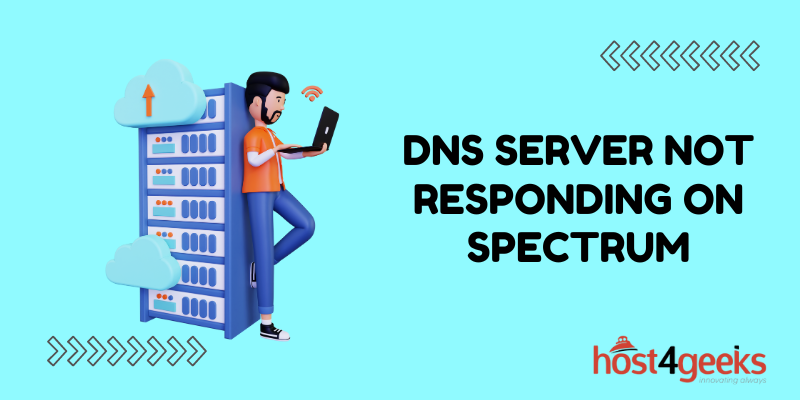In the ever-evolving landscape of digital connectivity, a reliable and swift internet connection has become an essential part of our daily lives.
However, amidst the seamless browsing and streaming experiences, there are moments when even the most steadfast internet connections falter, leaving us frustrated and disconnected.
One of the most perplexing and common issues that users encounter is the dreaded “DNS Server Not Responding” error on Spectrum, the gateway to our online world.
Fear not, for in this comprehensive troubleshooting guide, we delve into the intricacies of this issue, equipping you with the knowledge and solutions to navigate your way through the labyrinth of DNS woes.
Whether you’re a tech-savvy enthusiast or a casual user, join us as we unravel the mysteries behind DNS server hiccups and restore the digital highway to its full glory.
Understanding the Importance of DNS
DNS (Domain Name System) is the backbone of the internet, serving as a directory that translates user-friendly domain names into machine-readable IP addresses.
When you enter a website’s domain name in your browser, the DNS server takes charge of translating that name into an IP address, enabling your device to locate and access the requested site.
When a “DNS Server Not Responding” error occurs, it disrupts this translation process, leaving you unable to access websites by their names.
Troubleshooting Steps: Restoring Your Connection
Step 1: Initial Network Check
Before delving into complex solutions, let’s cover the basics. Make sure your device is properly connected to the Spectrum network. Inspect cables for any signs of damage or loose connections. Often, a simple cable adjustment can restore your connection.
Step 2: Reboot Your Router and Modem
Sometimes, a quick reboot is all it takes to remedy connectivity issues. Turn off your router and modem, wait for about 10 seconds, and then turn them back on. Allow a few minutes for the devices to fully reboot before testing your internet connection.
Step 3: Clearing the DNS Cache
Your device’s DNS cache might be housing outdated or corrupt data that’s causing the error. Clearing the cache can refresh the translation process. To do this:
Windows Users:
- Open the Command Prompt as an administrator.
- Type the command: ipconfig /flushdns
Press Enter to execute the command.
Mac Users:
- Launch the Terminal application.
- Enter the command: sudo dscacheutil -flushcache
- Press Enter and provide your admin password if prompted.
Step 4: Alternative DNS Servers
Consider switching to alternative DNS servers, like Google DNS or OpenDNS, which might offer more reliable performance. Here’s how:
Windows:
- Navigate to the Control Panel and then choose the option labeled “Network and Sharing Center.
- Click on your active connection and choose “Properties.”
- Select “Internet Protocol Version 4 (TCP/IPv4)” and click “Properties.”
- Opt for “Use the following DNS server addresses” and enter the preferred DNS server addresses.
Mac:
- Navigate to the Apple menu > System Preferences > Network.
- Choose your active connection and click “Advanced.”
- Head to the “DNS” tab and add the preferred DNS server addresses.
Step 5: Temporarily Disable Security Software
Firewalls and security software can sometimes interfere with DNS requests, leading to connection issues. Temporarily disable your security software and check if the error persists. Remember to enable the software once you’ve identified the cause.
Step 6: Restarting the DNS Client Service
On Windows systems, the DNS Client Service caches DNS data. Restarting this service might address the issue. Execute the following commands in Command Prompt as an administrator:
net stop dnscache
net start dnscache
Step 7: Power Cycle Your Device
When all else fails, performing a power cycle on your device can work wonders. Turn off your device, unplug it from the power source, wait for a minute, plug it back in, and power it on.
Step 8: Seek Support from Spectrum
If none of the above solutions resolve the problem, it’s time to seek assistance from Spectrum’s customer support. They can provide advanced troubleshooting steps or schedule a technician to resolve the issue.
In Conclusion: Ensuring Reliable Internet Access
Encountering a “DNS Server Not Responding” error can be a frustrating experience, but with the guidance provided in this comprehensive troubleshooting guide, you have the tools to tackle the issue with confidence.
By following these carefully outlined steps, you can effectively diagnose and resolve DNS server problems on your Spectrum connection.
A reliable DNS server is essential for smooth internet browsing, and by implementing these proactive solutions, you’ll be back online and enjoying a seamless online experience in no time.

